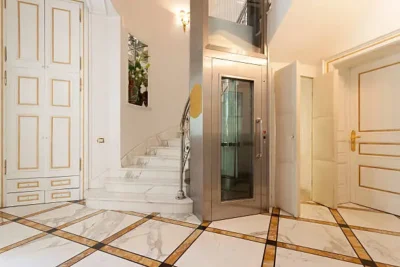From the EKAN Help Line
We received a call from a homeowner needing assistance with this project. These residents are retired and have a spectacular view of the ocean. Adding a lift to the home will enhance their comfort and will improve upon their mobility issues.
What You Need to Know About Installing an Elevator
Installing a personal elevator inside an existing house can be a complex project with several significant issues to consider. Here’s a discussion of the various aspects involved:
Foundation Improvement:
-
- Elevators are heavy, and adding one to an existing house may require foundation reinforcement to support the extra weight. A structural engineer should assess the foundation to ensure it can bear the load safely.
Structural Cutouts in Upper Floor:
-
- Creating an opening in the upper floor for the elevator shaft can impact the structural integrity of the house. Adequate support beams and load-bearing walls may need to be modified to accommodate the elevator.
Lateral Bracing:
-
- The elevator shaft must be braced laterally to prevent swaying or movement. This often involves adding additional structural elements or bracing to the existing building, which can be a complicated and costly process.
Ceiling Height:
-
- Elevator shafts need sufficient vertical space. Ensuring that your house has the necessary ceiling height for the elevator and complying with building codes is important.
Electrical Requirements:
-
- Installing an elevator will require an additional circuit in the electrical panel to power the elevator motor and control systems. A qualified electrician should handle this to ensure safety and compliance with electrical codes.
Noise of Operation:
-
- Elevators can generate noise during operation. Choose an elevator model designed for residential use and consider noise insulation to minimize disturbances to other parts of the house.
Strata Permission (if applicable):
-
- If your house is part of a strata or homeowners association, you may need to obtain permission to make structural changes to the building. This can involve a review of your plans and compliance with strata bylaws.
Emergency Power Supply:
-
- It’s essential to have an emergency power supply in case of a power outage, ensuring that the elevator can safely return to the ground floor or open its doors, allowing passengers to exit. This typically involves a backup generator or battery system.
Communications:
-
- Elevators may require a means of communication in case someone gets trapped inside. This often includes an emergency phone line or intercom system that connects to a monitoring service or emergency responders.
Building Permits:
-
- Some jurisdictions may require permits for elevator installation. You’ll need to submit detailed plans, undergo inspections, and adhere to local building codes and regulations.
Safety Regulations:
-
- Elevators are subject to safety regulations, which may include regular inspections and maintenance. Ensure that your elevator complies with all relevant safety standards to protect the occupants and maintain the longevity of the system.
Accessibility:
-
- If the elevator is intended for individuals with mobility issues, it should be designed to meet accessibility standards, which may include features like floor ramps, widened doors, grab bars, and appropriate button placement.
- If the elevator is intended for individuals with mobility issues, it should be designed to meet accessibility standards, which may include features like floor ramps, widened doors, grab bars, and appropriate button placement.
Cost:
-
-
- Elevator installation is a significant financial investment. Costs can vary widely based on the complexity of the project, the type of elevator, and the modifications required for your specific house.
- An annual inspection and scheduled servicing of the equipment is essential for trouble-free operation. Be sure to include a service agreement as part of the initial elevator package purchase order, not after the purchase.
- As a preliminary budget, a one story lift is estimated at $40K to $80K. However installation challenges, finishes and feature can easily double this estimate.
-
Support
Given the complexity of installing a personal elevator, it’s crucial to work with experienced professionals, including architects, structural engineers, electricians, and elevator installation specialists. They can help you navigate these issues and ensure a safe and compliant installation.
Consider your Options
The elevator installation cost may not necessarily be recovered in the sale price of the property. As an alternative, it may reasonable to consider moving and relocating into a mobility friendly home… a one story and at ground level.

